
My Role:
Project Time:
The Challenge:
UX Researcher, Prototyping, Usability Tester, Workshop Facilitator, UX/UI Designer.
5 weeks
As awareness of environmental impact grows, travelers struggle to find easy access to reliable, sustainable travel options. Whether it’s green transportation, eco-friendly accommodations, or responsible activities, information is scattered across multiple sources, leaving users uncertain about how to make eco-conscious choices without sacrificing quality experiences.
An app that brings together sustainable travel options—green transport, eco-friendly lodging, and responsible activities—into one easy-to-use platform. This helps users make eco-friendly choices effortlessly, allowing for more conscious, enjoyable travel experiences while addressing the demand for sustainable tourism.
The Solution:

Empathize Phase
Qualitative Research
I interviewed 5 potential users to understand the challenges they face when seeking sustainable travel options. Some sample questions included:
-
What obstacles do you face when choosing eco-friendly travel options?
-
Where do you typically find information on sustainable travel?
-
What motivates you to travel sustainably, and what makes it difficult to maintain?
-
How much effort are you willing to put into finding eco-friendly travel options?
-
What would make it easier for you to adopt more sustainable travel habits?
-
How does price affect your choice of sustainable travel options?
-
How important is it for you to track your carbon emissions while traveling?
Affinity Mapp from User Interview

Key Findings
-
Sustainable travel often takes more time and effort, making people prefer faster options.
-
Higher prices for eco-friendly choices discourage many, even with long-term benefits.
-
Users want simple, reliable information about eco-friendly choices.
-
A feature to measure and compare carbon emissions would be valuable.
-
People are motivated by saving time and money, so cost-effective solutions are key.
-
Social media like “Tiktok” and Google are key sources for sustainable travel info.
Quantitative Research
I conducted an online survey via Google Forms with 53 respondents to identify patterns and better understand potential users' needs, helping to frame the problem accurately.

Trends in Interest Over Time (Past 6 Months)

The survey validated earlier findings: cost and access to reliable information are key barriers, while there's strong interest in eco-friendly travel. Users are motivated by environmental impact and are open to paying more, but affordability is crucial.
-
Top choices: Green transportation (35%), eco-friendly accommodations (30%), responsible activities (25%).
-
Main barriers: High costs (40%), limited availability (25%), lack of information (20%).
-
Willing to pay more: 50%, but affordability matters.
-
Info sources: Social media (45%), search engines (35%).
-
Carbon tracking interest: 60%.
-
Main motivator: Environmental impact (50%), followed by cost savings (30%).
Summary
Competitive Analysis
Building on the survey insights, I conducted a competitive review to analyze leading companies in the sustainable travel sector. This helped identify their strengths, weaknesses, and growth opportunities, guiding us in refining our approach to stand out in the market.
TripAdvisor- SWTO
FairTrip -SWOT
BmyGuide - SWOT

Create Your First Project
Start adding your projects to your portfolio. Click on "Manage Projects" to get started
EcoTravels.2
Define Phase
Using the data gathered from the interview survey and competitive analysis, I developed a persona that represents the ideal user for the application.
Persona

Empathy Map
THINK
-
Can I travel sustainably without the hassle?
-
I care about the planet, but I still want fun.
-
There must be an easier way to find eco-friendly options.
FEEL
-
Frustrated: Struggling to find reliable eco-travel info.
-
Guilty: Torn between travel and its impact.
-
Excited: Eager to explore sustainably.
-
Overwhelmed: Too much info, not enough clarity.
DO
-
Looks for green travel options and eco-friendly stays.
-
Follows travel blogs and influencers for tips.
-
Tries to support local businesses when traveling.
SAY
-
"I love traveling, but finding sustainable options is so hard."
-
"It’s tough to know where to start with eco-friendly travel."
-
"I want to explore without harming the planet."

Ideate Phase
Ideation Workshop
A structured ideation workshop was conducted to generate innovative ideas and gather fresh perspectives. Four participants from the target group participated remotely, using Miro as the collaborative tool. I facilitated the session, guiding the participants through the process.
Brainstorm
Mindmap
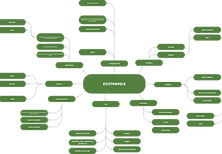

The "100 $" Test

Top Idea
Short text about that the ideationworksshops results lead to this:

Concept 01,
Sustainability Labels
This concept uses intuitive symbols to highlight sustainable travel options, like vegan choices or low-carbon transport. Read more
Concept 02,
EcoCoins
Concept 02 introduces a rewarding point system, where users can earn Eco-coins by booking travel or participating in games within the app. Read more
Concepts 03,
Pack'n'Go
Concept 03 presents the Pre-Planned Travel Package, ideal for those seeking spontaneity, indecision, or a quick getaway. Read more

Selected Solution - Concept 01:
Research highlighted the need for clear identification of eco-friendly options. By using symbols next to choices, we can improve user comprehension and accessibility, creating a universal language that users can easily understand, whether actively or passively. This addresses the gap identified in the literature review, where many users are unaware of sustainable options, leading to less eco-friendly choices. Findings from interviews and workshops confirmed that this feature is a key solution for encouraging sustainable decisions.Selected Solution - Concept 01:
User Flow
I used Figma to create a visual map of how users will navigate through the app, showing the steps they will take from one screen to the next.

Information Architecture
Based on the card sorting results, I refined the information architecture to align with the app's goals. Some features were re-categorized for easier access and improved usability.

Prototype Phase
High-Fidelity Wireframes
I started by sketching low-fidelity wireframes on paper, making revisions based on UX guidelines. After that, I moved on to designing the high-fidelity wireframes in Figma.






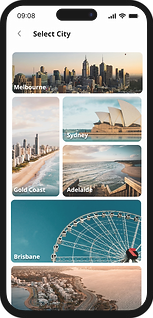




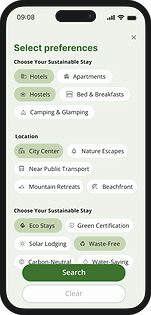
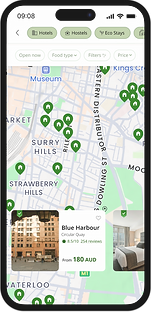



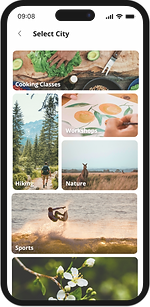




Conclusion:
This project successfully addressed the need for simplified access to sustainable travel options by consolidating eco-friendly choices on a single platform. User research highlighted the importance of clear eco-identifiers, cost-effectiveness, and carbon tracking in promoting sustainable travel. Usability testing provided valuable insights, leading to enhancements such as improved error recovery, increased personalization, and more accessible support features. The final solution significantly improved the overall user experience, empowering travelers to make informed, eco-conscious decisions while resolving critical pain points. This project ultimately contributes to promoting sustainable travel and encourages users to make more environmentally responsible choices.